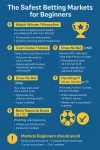- Joined
- Jul 11, 2008
- Messages
- 1,355
- Reaction score
- 174
- Points
- 63
Match Winner / Moneyline
The most straightforward market: you simply pick who wins the match. No spreads, no complications, no special rules. Why it’s safe: it’s easy to understand, it teaches you how teams actually play, and you don’t need advanced math to know what you’re betting. It works well across football, basketball, tennis, MMA, and esports. For most beginners, this is the first market to learn before touching anything more complex.Over/Under (Totals)
Instead of picking a winner, you’re betting on whether the total score goes over or under a set line. Why it’s safe: it removes the need to call the winner, often behaves more predictably than match outcomes, and fits simple research like pace, injuries, form, or weather. Totals are popular and beginner-friendly in football goals, basketball points, tennis sets, and esports maps.Double Chance
A beginner-friendly football market that covers two outcomes at once. You can back: home win or draw, away win or draw, or either team to win (no draw). Why it’s safe: it reduces risk, raises your hit rate, and helps you build confidence without needing perfect reads. It’s one of the best “training wheels” markets in football.Draw No Bet (DNB)
With DNB, if the match ends in a draw your stake is refunded. Why it’s safe: it removes the draw as a losing result, keeps volatility lower than standard match winner, and is great when one team looks stronger but not dominant. Beginners like it because it gives protection without changing the core idea of “pick the better side.”Handicap 0 (Asian Handicap 0)
Also written as AH 0. If the game is a draw, you get your stake back — basically the Asian-market version of DNB. Why it’s safe: it’s a risk-reduced winner bet, a clean introduction to Asian handicap logic, and useful in balanced matches where you want protection. It’s a good bridge between basic and advanced handicaps.Both Teams to Score (BTTS)
You’re only predicting whether both teams score at least one goal. It’s a simple yes/no market. Why it’s safe: no need to pick a winner, the logic is clean, and basic stats often point you in the right direction (goal trends, injuries, home/away styles). For football beginners, BTTS is one of the easiest “pattern markets” to learn.Safe Prop Bets (Simple Player/Team Props)
Props can be dangerous when they get too specific, but some are beginner-friendly. Examples: team over 0.5 goals, player to score anytime, team total corners over/under, or first to 5 points in basketball/volleyball. Why these are safe: low complexity, easy to research, and you’re not trying to predict the entire match script.Markets Beginners Should Avoid (For Now)
These are where new bettors lose money fastest: parlays/accumulators, complex Asian handicaps like -1.75 or +2.25, correct score bets, ultra-specific player props, live bets without watching, and long-shot “fun specials.” They look exciting, but variance and pricing punish you hard before you’ve built skills. Park them until you’re stable in simple markets.Final Tips for Beginners
Stick to simple markets first, research only the basics, compare prices before betting, track your bets so you learn from clean samples, and focus on one sport until you understand it deeply. Mastering safe markets builds confidence, reduces risk, and teaches the fundamentals of sharp betting. Once these feel automatic, you’ll be ready to explore advanced markets without melting your bankroll.FAQ
Q1: What’s the #1 safest market to start with?A: Match winner/moneyline, because it’s simple and teaches you the core habit of judging price vs chance.
Q2: Are props always risky for beginners?
A: Not all. Simple props like team over 0.5 goals or basic totals can be very safe if you keep them broad.
Q3: When should I try parlays or complex handicaps?
A: After you’ve proven consistency in simple markets and can handle variance without changing stakes.
Next in Beginner Series: Mistakes Beginner Bettors Must Avoid
Previous: How to Manage Your Bankroll (Beginner Edition)
Attachments
Last edited:


